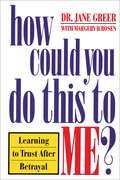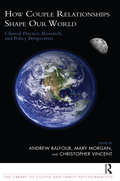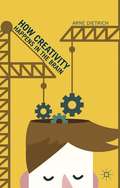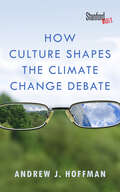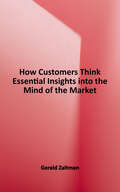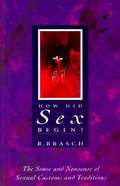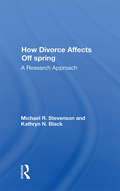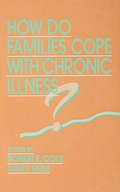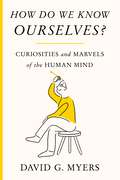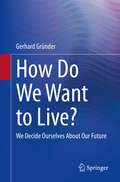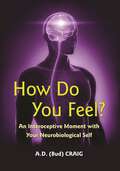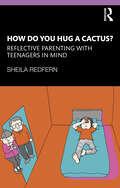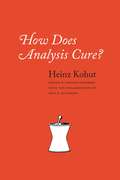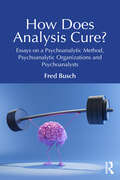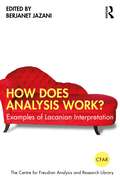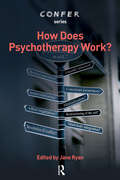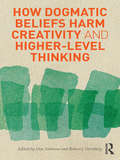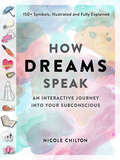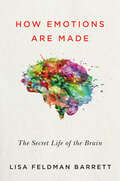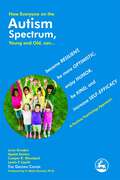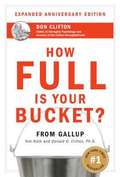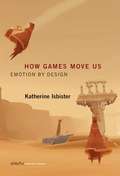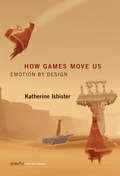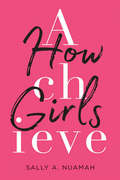- Table View
- List View
How Could You Do This to Me?
by Jane GreerAt one time or another we have all been betrayed by someone we trusted, all felt the sting of deceit and subsequent shattering of self-confidence. And when the people we count on betray our trust, the wound is deep and long-lasting.In How Could You Do This to Me?, Dr. Jane Greer teaches readers:the types of people who are more at risk of betrayal the warning signs of someone who is untrustworthy a process that helps decide whether a relationship is worth saving or whether it should be abandoned.Part One discusses the roots of trust, blind trust, and the reasons betrayers betray. Part Two reveals our betrayers' many faces: admirers, users, or rivals. Part Three focuses on the fallout from betrayal: confrontation, revenge, and betrayal, and talks about how you can learn to trust your judgment and others again.From the Trade Paperback edition.
How Couple Relationships Shape our World: Clinical Practice, Research, and Policy Perspectives (The Library of Couple and Family Psychoanalysis)
by Mary Morgan Andrew Balfour Christopher VincentThis book is about the importance of the couple relationship in the broadest terms. It draws on clinical researches into the inner lived world of adult couples, empirical developmental research into children and parenting, as well as the legal setting when relationships break down. It aims to bridge the inner and outer worlds, showing how our most intimate relationships have vital importance at all levels, from the individual and the family, to the social setting - and explores the implications for practice and policy. Above all, it is a book about applications of clinical thinking linked with research knowledge, as tools for front line workers and policy makers alike. It draws on the tradition of applied clinical thinking and research of the Tavistock Centre for Couple Relationships, linking current thinking with the history of ideas in each area it covers, as well as considering implications for the future.
How Creativity Happens in the Brain
by Arne DietrichHow Creativity Happens In The Brain is about the brain mechanisms of creativity, how a grapefruit-sized heap of meat crackling with electricity manages to be so outrageously creative. It has a sharp focus: to stick exclusively to sound, mechanistic explanations and convey what we can, and cannot, say about how brains give rise to creative ideas.
How Culture Shapes the Climate Change Debate
by Andrew J. HoffmanThough the scientific community largely agrees that climate change is underway, debates about this issue remain fiercely polarized. These conversations have become a rhetorical contest, one where opposing sides try to achieve victory through playing on fear, distrust, and intolerance. At its heart, this split no longer concerns carbon dioxide, greenhouse gases, or climate modeling; rather, it is the product of contrasting, deeply entrenched worldviews. This brief examines what causes people to reject or accept the scientific consensus on climate change. Synthesizing evidence from sociology, psychology, and political science, Andrew J. Hoffman lays bare the opposing cultural lenses through which science is interpreted. He then extracts lessons from major cultural shifts in the past to engender a better understanding of the problem and motivate the public to take action. How Culture Shapes the Climate Change Debate makes a powerful case for a more scientifically literate public, a more socially engaged scientific community, and a more thoughtful mode of public discourse.
How Customers Think: Essential Insights into the Mind of the Market
by Gerald ZaltmanHow to unlock the hidden 95 percent of the customer's mind that traditional marketing methods have never reached. This title provides a practical synthesis of the cognitive sciences. Drawing heavily on psychology, neuroscience, sociology, and linguistics, Zaltman combines academic rigor with real-world results to offer highly accessible insights, based on his years of research and consulting work with large clients like Coca-Cola and Procter & Gamble. An all-new tool kit: Zaltman provides research tools - metaphor elicitation, response latency, and implicit association techniques, to name a few - that will be all-new to marketers, and demonstrates how innovators can use these tools to get clues from the subconscious when developing new products and finding new solutions, long before competitors do.
How Did Sex Begin?
by R. BraschWitty, candid investigation of the myths, traditions and practices surrounding this most popular of human pursuits, originally published in Australia in 1973. The author has written 30 books including 'How did Sport Begin?' and 'There's a Reason for Everything'. He is a scholar in the fields of theology, philosophy and history and was awarded the Media Peace prize in 1979.
How Divorce Affects Offspring: A Research Approach
by Michael R. StevensonIn Qur experience, there is bias and inconsistency in much of what is written about the effects of divorce on offspring. When interested students have asked for appropriate resources, we have been hard-pressed to respond without providing a long list of contradictory sources. Much of what is currently available reflects the cultural bias that parental divorce is one of the worst things that can happen to offspring. This book has grown out of our desire to provide a comprehensive, accessible, balanced, and readable resource for upper-level undergraduate and graduate students who are interested in the effects of divorce upon offspring. We also hope that it will be useful to parents and practicing professionals who are not familiar with the empirical literature addressing this situation. Our primary goal is to evaluate and summarize the empirical literature in this field. However, we illustrate important points with examples drawn from autobiographies completed as part of a class assignment or from client histories based on one of the author's (KNB) counseling with families who are experiencing separation and divorce. We have selected life stories that describe problems in order to show possible results and that even difficult situations can have a positive resolution. Although the individuals involved may recognize themselves, there is insufficient information for anyone else to make an identification.
How Do Families Cope With Chronic Illness? (Advances in Family Research Series)
by David Reiss Robert E. ColeBecause chronic disorder is becoming an ordinary feature of family life and development, understanding its impact has become critical. This volume, and the conference proceedings it reports, represents a major effort to examine the family's response to chronic physical or psychopathological illness in one or more of its members. Recent data are revising our notions of chronic illness. Evidence is mounting that chronic psychiatric disorders reflect, in part, abnormalities of brain structure and function. In this sense, they are, in part, medical disorders. On the other hand, a number of traditionally labeled medical disorders produce a broad range of psychological symptoms and are exquisitely sensitive to psychosocial influences. Families undergo a complex process of adaptation during which their response to stress and their fundamental beliefs about learning and parenting change. These beliefs endure and are difficult to alter. By examining the processes in a wide range of chronic conditions, this volume helps to identify the common, underlying processes of adaptation. The first three chapters concern the families' responses to disorders that are distinctly medical; the next three focus on families' responses to "grey zone" disorders or anomalies that appear early in life, minor physical anomalies, and communication handicaps; and one chapter focuses exclusively on schizophrenia. The last chapter reflects an effort to develop a model based on the experience of researchers with both psychiatric and medical illness.
How Do We Know Ourselves?: Curiosities and Marvels of the Human Mind
by David G. Myers“Each chapter is a gem of insight into the human experience, cut and polished to perfection by the renowned psychologist David Myers. Better than any book I can recall, this book answers questions about why we think, feel, and act as we do—but also makes us curious to learn more.” —Angela DuckworthA delightful tour of the wonders of our humanity from David G. Myers, the award-winning professor and author of psychology’s bestselling textbook.Over the past three decades, millions of students have learned about psychology from textbooks by David G. Myers. To create these books and to satisfy his own endless curiosity about the human mind, Myers monitors the leading journals to discover the most extraordinary developments in psychological science.How Do We Know Ourselves? is a compendium of the most wondrous verities that Myers has found, revealing thought-provoking insights into our everyday lives. His astute observations and sharp-witted wisdom enable readers to think smarter and live happier.Myers’s subjects range from why we so often fear the wrong things to how simply going for a walk with someone can increase rapport and empathy. He reveals why we repeatedly mishear song lyrics and how the color of President Obama’s suits aided in his decision-making. Myers also explores the powers and perils of our intuition, explaining why anything can seem obvious once it happens.These forty essays offer fresh insight into our sometimes bewildering but ever-fascinating lives. Myers is engaging and intellectually provocative, and he brings a wealth of knowledge from more than fifty years of teaching and writing about psychology to this lively and informative collection. He inspires us to ponder timeless questions, including what might be the most intriguing one of all: How do we know ourselves?
How Do We Want to Live?: We Decide Ourselves About Our Future
by Gerhard GründerDo you also ask yourself how much your thinking, feeling and behavior are determined by your genes and biology? Do you doubt that interfering with our brain chemistry will make us happier and more content people? Are you skeptical that computer algorithms can capture your essence as a human being?This nonfiction book challenges the worldview of "divine man" (Harari), in which humans are determined by their biology and medicine serves to optimize them. The author shows that we are the active designers of our living conditions and thus determine our own physical and mental health.Be inspired to participate in shaping the future of a human society in which we have to decide where we live, how we live with each other, how we work, and how we educate ourselves. Target Audiences:Ideal for anyone interested in the fundamentals of brain research, psychology, and psychiatry, and who is concerned about the nature of human beings and their future.About the Author: Prof. Dr. Gerhard Gründer, psychiatrist and psychotherapist, is a professor at the University of Heidelberg. He heads the Department of Molecular Neuroimaging at the Central Institute of Mental Health in Mannheim. This book is a translation of the original German 1st edition Wie wollen wir leben? by Gerhard Gründer, published by Springer-Verlag GmbH, DE, part of Springer Nature in 2020. The translation was done with the help of artificial intelligence (machine translation by the service DeepL.com). A subsequent human revision was done primarily in terms of content, so that the book will read stylistically differently from a conventional translation. Springer Nature works continuously to further the development of tools for the production of books and on the related technologies to support the authors.
How Do You Choose?: A Human Design Guide to What's Best for You at Work, in Love, and in Life
by Erin Claire JonesDo you know what career you’re really meant to pursue? Can you identify the relationships you should really be investing in? Are you living your life to the fullest? Human Design is a mystical personality assessment that uses NASA data, astrology, and Eastern philosophy to generate mind-blowingly accurate insights into how you uniquely thrive at work, in love, and beyond.In How Do You Choose?, world-renowned Human Design coach and educator Erin Claire Jones offers a roadmap to using this cosmic system as a practical tool for transformation.Written as an easy-to-understand guide, Jones shares relatable stories from her own life, case studies from her work with thousands of clients, examples of how influential figures like Nelson Mandela, Taylor Swift, Beyoncé, Maya Angelou and more have used their Human Design gifts to change the world, actionable tips for immediate transformation, and more than a hundred journaling prompts.After reading, you will learn:The professional roles you’re designed to pursue The relationship dynamics that make you feel most seenYour most potent communication strategies with colleagues, family, and friendsThe gifts you bring to a team and how you can be most effectiveThe way you are uniquely designed to make decisions of all kindsAlong the way, you will also become fluent in the language of Human Design as you dive into the fundamentals of Type, Strategy, and Authority, and discover how these elements can influence every decision you make.Whether you want to advance your career, motivate others to change, take creative risks, find deeper connections, build better habits, start a new chapter, or simply create more happiness in your life and relationships, How Do You Choose? offers you a resource to shift your mindset and unlock your full potential.
How Do You Feel?: An Interoceptive Moment with Your Neurobiological Self
by A. D. CraigA book that fundamentally changes how neuroscientists and psychologists categorize sensations and understand the origins and significance of human feelingsHow Do You Feel? brings together startling evidence from neuroscience, psychology, and psychiatry to present revolutionary new insights into how our brains enable us to experience the range of sensations and mental states known as feelings. Drawing on his own cutting-edge research, neurobiologist Bud Craig has identified an area deep inside the mammalian brain—the insular cortex—as the place where interoception, or the processing of bodily stimuli, generates feelings. He shows how this crucial pathway for interoceptive awareness gives rise in humans to the feeling of being alive, vivid perceptual feelings, and a subjective image of the sentient self across time. Craig explains how feelings represent activity patterns in our brains that signify emotions, intentions, and thoughts, and how integration of these patterns is driven by the unique energy needs of the hominid brain. He describes the essential role of feelings and the insular cortex in such diverse realms as music, fluid intelligence, and bivalent emotions, and relates these ideas to the philosophy of William James and even to feelings in dogs.How Do You Feel? is also a compelling insider's account of scientific discovery, one that takes readers behind the scenes as the astonishing answer to this neurological puzzle is pursued and pieced together from seemingly unrelated fields of scientific inquiry. This book will fundamentally alter the way that neuroscientists and psychologists categorize sensations and understand the origins and significance of human feelings.
How Do You Hug a Cactus? Reflective Parenting with Teenagers in Mind
by Sheila RedfernHave you ever wondered what’s going on in your teenager’s mind? This engaging book will give you the tools to understand just that to ultimately help you keep the close connection you both need during these tricky years.Following on from her acclaimed book for parents of younger children, Sheila Redfern brings the reflective parenting model to parents of teenagers. Teenagers can be experienced as prickly and hard to get close to – like a cactus – but Dr. Redfern shows us how this stage of your child's life can be more enjoyable and connected than you'd imagined. Rather than focusing on their behaviours, this book emphasises how we can teach teenagers to manage their feelings and relationships in safe ways. It advocates theories underpinning reflective parenting – mentalizing, attachment and neuroscience – as essential for building resilience and security in young people, which is crucial through the storm and stress of adolescence. Chapters are filled with everyday, relatable scenarios and practical advice on pressing issues such as self-harm, social media and gaming, risk and ASD. There is also a chapter devoted to adoptive parents and foster carers.This practical guide aims to help readers become more reflective and available as parents and understand what might be in their teenager’s head. It also serves as an essential resource for clinicians working with families.
How Does Analysis Cure?
by Heinz Kohut Paul E. StepanskyThe Austro-American psychoanalyst Heinz Kohut was one of the foremost leaders in his field and developed the school of self-psychology, which sets aside the Freudian explanations for behavior and looks instead at self/object relationships and empathy in order to shed light on human behavior. In How Does Analysis Cure? Kohut presents the theoretical framework for self-psychology, and carefully lays out how the self develops over the course of time. Kohut also specifically defines healthy and unhealthy cases of Oedipal complexes and narcissism, while investigating the nature of analysis itself as treatment for pathologies. This in-depth examination of “the talking cure” explores the lesser studied phenomena of psychoanalysis, including when it is beneficial for analyses to be left unfinished, and the changing definition of “normal.” An important work for working psychoanalysts, this book is important not only for psychologists, but also for anyone interested in the complex inner workings of the human psyche.
How Does Analysis Cure?: Essays on a Psychoanalytic Method, Psychoanalytic Organizations and Psychoanalysts
by Fred BuschBuilding upon 50 years of clinical experience, Fred Busch addresses a central question facing all psychoanalysts: What is essential to a psychoanalytic curative process, and what are the methods of working that can bring this about?This book investigates the analytic relationship as a process of giving patients the freedom to think the unthinkable (to build representations) and change repeated patterns of action into the possibility of reflection. This entails careful examination of central psychoanalytic concepts such as transference, resistances, and the ethics of countertransference as a guide to a patient’s unconscious, in addition to newer ideas, such as the notion of the analyst as a memory keeper of patients’ lost objects. In its final part, the book presents observations on how analysts function as part of analytic organizations, and the various roles they take on to develop an “analytic identity”.Continuing decades of significant theoretical work on clinical concepts, this book offers a unique perspective on how psychoanalysts and psychotherapists can work effectively to achieve the best possible outcomes for their patients.
How Does Analysis Work?: Examples of Lacanian Interpretation (The Centre for Freudian Analysis and Research Library (CFAR))
by Berjanet JazaniHow Does Analysis Work? uses short, compelling vignettes from people in Lacanian analysis to explore how analytic interpretation works.Insights, revelations, connections, meanings and non-meanings all feature in these anonymous accounts of crucial moments in analysis, providing a sense of what it is all about. Drawn from a wide range of analysands, some seasoned analysts and others just starting out, these vignettes show how change takes place. The short pieces are drawn from Lacanian analysis, but many go against cliched views of what Lacanians do in their work, spanning both the classical and the radically innovative and showing the use of humour and theatre in psychoanalytic practice.How Does Analysis Work? will be of great interest to psychoanalysts and Lacanian analysts in practice and in training, as well as anyone who is curious about the analytic process.
How Does Psychotherapy Work?
by Jane RyanIt is said that the question "how does psychotherapy work?" cannot be answered conclusively - that we cannot reach into the depths of a deeply private relationship and pluck out a precise truth about what occurs within it. This book defies that notion. Here, the question is both beautifully explored and answered by leading psychotherapists from different schools to create a fascinating volume of ground-breaking ideas and theory. Each contributor unravels the procedures of the work, discussing the qualities of good psychotherapy from their own personal and theoretical perspectives. They explore the reasons why people seek help, how they can be helped and the goals of the therapeutic journey, each of them writing with precision, clarity and passion for the work they do. Despite the wide range of variations in their theory and technique the eleven contributors to this book are united in finding certain common denominators in successful psychotherapy.
How Dogmatic Beliefs Harm Creativity and Higher-Level Thinking (Educational Psychology Series)
by Don Ambrose and Robert J. SternbergIn a world plagued by enormous, complex problems requiring long-range vision and interdisciplinary insights, the need to attend to the influence of dogmatic thinking on the development of high ability and creative intelligence is pressing. This volume introduces the problem of dogmatism broadly, explores the nature and nuances of dogmatic thinking from various disciplinary perspectives, and applies the gleaned insights to what is known about creativity. Bringing together leading thinkers in the fields of creative studies and education, and in other relevant fields (history, sociology, psychology) whose work pertains to the various dimensions of dogmatism and the ethical problems it generates, this panoramic view represents interdisciplinary bridge building with the potential to generate new insights about the education of creative young minds.
How Dreams Speak: An Interactive Journey into Your Subconscious (150+ Symbols, Illustrated and Fully Explained)
by Nicole ChiltonUnlock the mysteries! What does it mean to dream about a doll? Perhaps your inner child needs to come out and play. Or what if you find yourself flying high above the earth? It&’s your sleeping mind urging your waking mind to look to the future and think about your deepest aspirations. Richly illustrated in watercolor and with explanations and intuitive prompts throughout, How Dreams Speak is a unique visual dream interpretation guide that demystifies over 150 universal symbols and themes. With this book in hand, you&’ll learn the history of dream interpretation and the science of dreaming and be guided through the practice of remembering—then untangling—your nightly adventures. Our dreams speak to us, and within these pages lies the gifts of being able to listen to what our subconscious mind is saying.
How Emotions Are Made: The Secret Life of the Brain (Expert Thinking Ser.)
by Prof. Lisa Feldman BarrettA new theory of how the brain constructs emotions that could revolutionize psychology, health care, law enforcement, and our understanding of the human mind Emotions feel automatic, like uncontrollable reactions to things we think and experience. Scientists have long supported this assumption by claiming that emotions are hardwired in the body or the brain. Today, however, the science of emotion is in the midst of a revolution on par with the discovery of relativity in physics and natural selection in biology—ans this paradigm shift has far-reaching implications for us all. Leading the charge is psychologist and neuroscientist Lisa Feldman Barrett, whose theory of emotion is driving a deeper understanding of the mind and brain, and shedding new light on what it means to be human. Her research overturns the widely held belief that emotions are housed in different parts of the brain and are universally expressed and recognized. Instead, she has shown that emotion is constructed in the moment, by core systems that interact across the whole brain, aided by a lifetime of learning. This new theory means that you play a much greater role in your emotional life than you ever thought. Its repercussions are already shaking the foundations not only of psychology but also of medicine, the legal system, child-rearing, meditation, and even airport security. Why do emotions feel automatic? Does rational thought really control emotion? How does emotion affect disease? How can you make your children more emotionally intelligent? How Emotions Are Made answers these questions and many more, revealing the latest research and intriguing practical applications of the new science of emotion, mind, and brain.
How Everyone on the Autism Spectrum, Young and Old, can...
by June Groden Ayelet Kantor Cooper R. Woodard Lewis P. Lipsittxx
How Full Is Your Bucket?
by Donald O. Clifton Tom RathOrganized around a simple metaphor of a dipper and a bucket -- already familiar to thousands of people -- How Full is Your Bucket? shows how even the smallest interactions we have with others every day profoundly affect our relationships, productivity, health, and longevity. Co-author Donald O. Clifton studied the effects of positive and negative emotions for half a century, and he and his colleagues interviewed millions of people around the world. Their discoveries contributed to the emergence of an entirely new field: Positive Psychology. These same discoveries are at the heart of How Full is Your Bucket? Clifton, who also coauthored the bestseller Now, Discover Your Strengths, penned How Full is Your Bucket? with grandson Tom Rath. Written in an engaging, conversational style, their book includes colorful stories, 5 strategies for increasing positive emotions, and features an online test that measures readers' Positive Impact. How Full is Your Bucket? is a quick, breezy read. It will immediately help readers boost the amount of positive emotions in their lives, and in the lives of everyone around them. The book is sure to inspire lasting changes in all who read it, and has all the makings of a timeless classic.
How Games Move Us: Emotion by Design
by Katherine IsbisterThis is a renaissance moment for video games -- in the variety of genres they represent, and the range of emotional territory they cover. But how do games create emotion? In How Games Move Us, Katherine Isbister takes the reader on a timely and novel exploration of the design techniques that evoke strong emotions for players. She counters arguments that games are creating a generation of isolated, emotionally numb, antisocial loners. Games, Isbister shows us, can actually play a powerful role in creating empathy and other strong, positive emotional experiences; they reveal these qualities over time, through the act of playing. She offers a nuanced, systematic examination of exactly how games can influence emotion and social connection, with examples -- drawn from popular, indie, and art games -- that unpack the gamer's experience.Isbister describes choice and flow, two qualities that distinguish games from other media, and explains how game developers build upon these qualities using avatars, non-player characters, and character customization, in both solo and social play. She shows how designers use physical movement to enhance players' emotional experience, and examines long-distance networked play. She illustrates the use of these design methods with examples that range from Sony's Little Big Planet to the much-praised indie game Journey to art games like Brenda Romero's Train. Isbister's analysis shows us a new way to think about games, helping us appreciate them as an innovative and powerful medium for doing what film, literature, and other creative media do: helping us to understand ourselves and what it means to be human.
How Games Move Us: Emotion by Design (Playful Thinking)
by Katherine IsbisterAn engaging examination of how video game design can create strong, positive emotional experiences for players, with examples from popular, indie, and art games. This is a renaissance moment for video games—in the variety of genres they represent, and the range of emotional territory they cover. But how do games create emotion? In How Games Move Us, Katherine Isbister takes the reader on a timely and novel exploration of the design techniques that evoke strong emotions for players. She counters arguments that games are creating a generation of isolated, emotionally numb, antisocial loners. Games, Isbister shows us, can actually play a powerful role in creating empathy and other strong, positive emotional experiences; they reveal these qualities over time, through the act of playing. She offers a nuanced, systematic examination of exactly how games can influence emotion and social connection, with examples—drawn from popular, indie, and art games—that unpack the gamer's experience. Isbister describes choice and flow, two qualities that distinguish games from other media, and explains how game developers build upon these qualities using avatars, non-player characters, and character customization, in both solo and social play. She shows how designers use physical movement to enhance players' emotional experience, and examines long-distance networked play. She illustrates the use of these design methods with examples that range from Sony's Little Big Planet to the much-praised indie game Journey to art games like Brenda Romero's Train. Isbister's analysis shows us a new way to think about games, helping us appreciate them as an innovative and powerful medium for doing what film, literature, and other creative media do: helping us to understand ourselves and what it means to be human.
How Girls Achieve
by Sally A. NuamahThis bold and necessary book points out a simple and overlooked truth: most schools never had girls in mind to begin with. That is why the world needs what Sally Nuamah calls feminist schools, deliberately designed to provide girls with achievement-oriented identities. And she shows why doing so would help all students, regardless of their gender.
